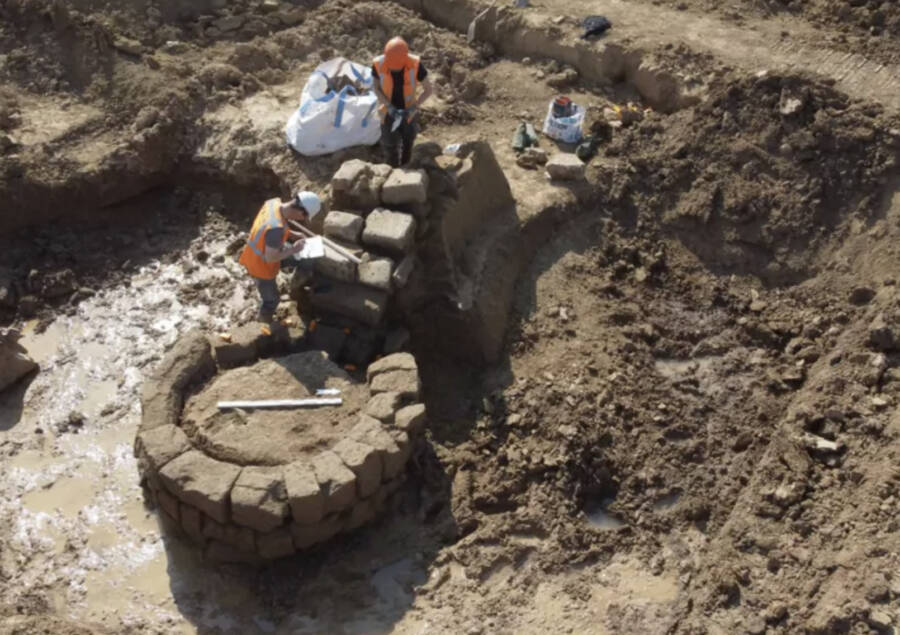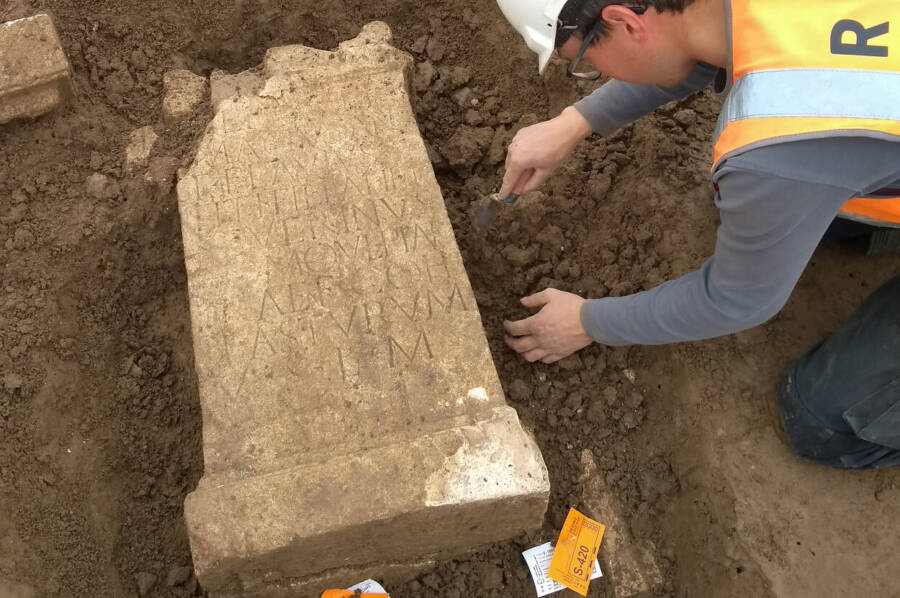Archaeologists have found two temples that they believe were used by Roman soldiers as early as the first century C.E. along with altar stones and carvings of deities.

RAAPArchaeologists uncovered a stone well in addition to sculptures, painted plaster walls, and remnants of armor.
Amateur archaeologists digging at a clay extraction site in the Netherlands came across the find of their lives in late 2021 when they unearthed a nearly-intact Roman temple complex. Dating to the first century C.E., the structures were likely used by soldiers stationed at the Roman Empire’s northern boundary.
According to a press release from the Dutch National Office for Cultural Heritage, the complex is located in the village of Herwen-Hemeling near the Roman Limes, or Limes Germanicus, a UNESCO World Heritage Site comprising a series of outposts and fortifications along what was once the empire’s edge.
When the amateur archaeologists stumbled upon ancient Roman artifacts while digging at the Gelderland province site, they immediately notified professionals, who have spent the first half of 2022 uncovering what they say is an “exceptional” find.
“Never before has such a complete complex been found in the Netherlands,” the cultural heritage agency stated in the press release. So far, experts have found two temples: one larger Gallo-Roman structure with “colorfully painted walls and a tiled roof” and another smaller temple several yards away, “also with beautifully painted walls.”
They’ve also discovered statues of various deities, a large stone well, cloak pins, and roof tiles carved with inscriptions. It’s these tiles that suggest the complex was used primarily by soldiers since the military was in charge of creating the tiles at the time, according to Deutsche Welle.

RAAPOne of the excavated roof tiles with an inscription.
In the first century B.C.E., Julius Caesar led a military campaign against Gaul — an ancient territory made up of parts of France, Belgium, Switzerland, Germany, and the Netherlands — and swiftly conquered the region, according to Ancient Origins. After Caesar’s success in the Gallic Wars, the area that is now the Netherlands became part of the northern border of the Roman Empire, and soldiers arrived to protect the region from Germanic tribes.
Between the first and fourth centuries C.E., soldiers likely used the newly-discovered temple to make sacrifices and offerings to various gods and goddesses. Archaeologists have unearthed dozens of small stone altars, some of which are dedicated to the gods Hercules Magusanus, Jupiter-Serapis, and Mercury.
What’s more, the inscriptions on some of these stones show what these soldiers were thankful for. According to the press release, “High-ranking Roman officers erected dozens of votive stones to give thanks to a god or goddess for fulfilling their wishes. These did not always relate to winning battles. Simply surviving a stay in these northern regions, sometimes far from home, was often reason enough to give thanks.”
In addition to the altars, archaeologists have found large pits that soldiers used for sacrificial fires, tips of spears and lances, and fragments of armor and horse harnesses. Experts say the wide variety of items and inscriptions uncovered so far demonstrate how much migration was occurring at the time, as they’ve found evidence of soldiers from as far away as Hungary, Spain, and Africa.

RAAPSeveral dozen inscribed altar stones were found in the temple complex.
While the discovery of this temple complex is important for its insight into the past, it’s also rare to find buildings from the time period so intact. According to the cultural heritage agency, “The site at Herwen-Hemeling is unusually complete. In later periods, Roman buildings were regularly used as an easy source of ready-made building materials and the stones were incorporated into later building projects.”
“But that happened much less at this site,” the release continues. “Votive stones, pedestals, a stone well, parts of statues — they can all still be found here.”
After further examination, the artifacts pulled from the site will be displayed at the Valkhof Museum in the nearby city of Nijmegen.
For Peter Drenth, the Dutch Commissioner responsible for heritage, this new discovery is an exciting opportunity to share the Netherlands’ history with both Dutch citizens and the international community.
“This is a valuable addition to our story about the Roman Limes,” he said. “We are now going to investigate and explore this beautiful site as thoroughly as we can, and show it to the people of Gelderland.”
After learning about the ancient Roman temple complex unearthed in the Netherlands, read about the Roman mosaic found in a busy area of London. Then, learn how archaeologists in Turkey uncovered a 2,000-year-old Roman sewer system.





